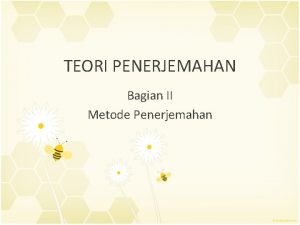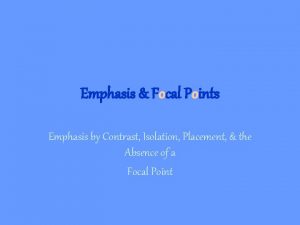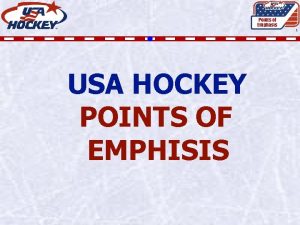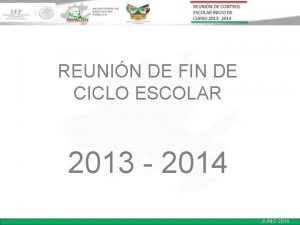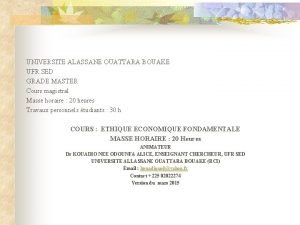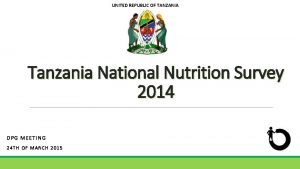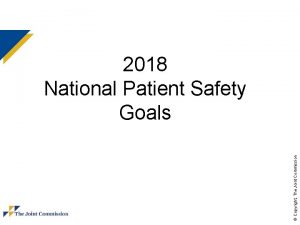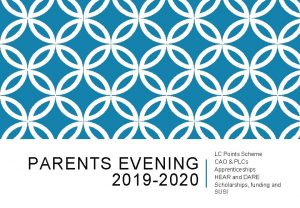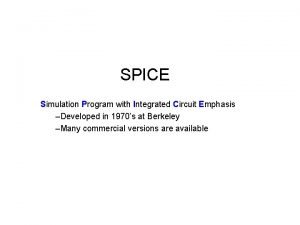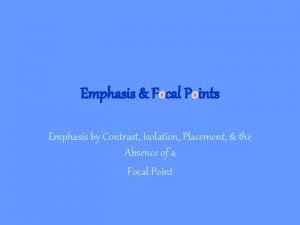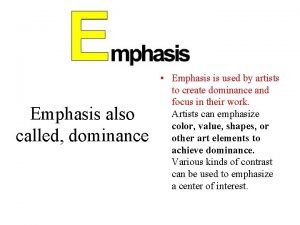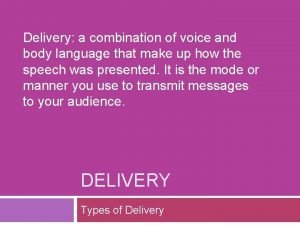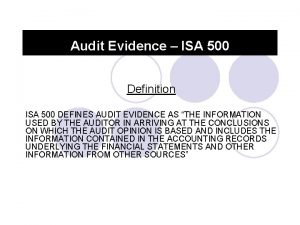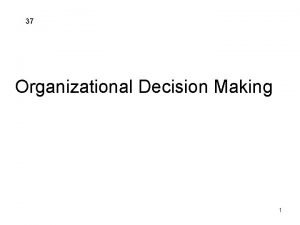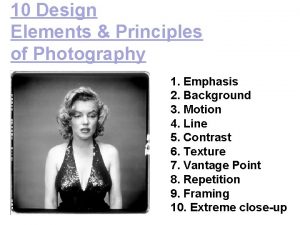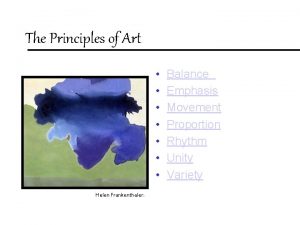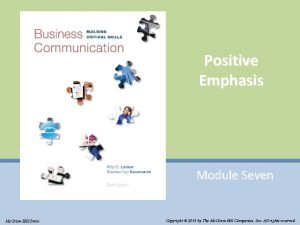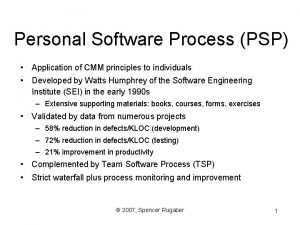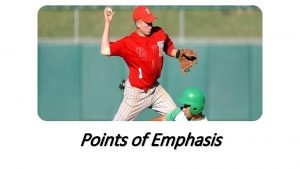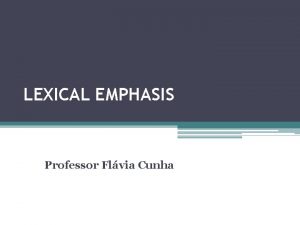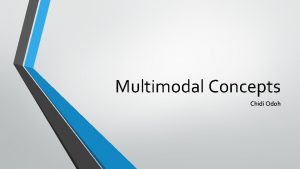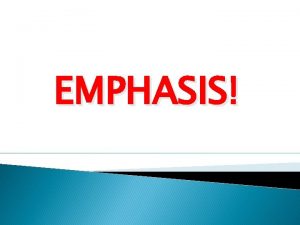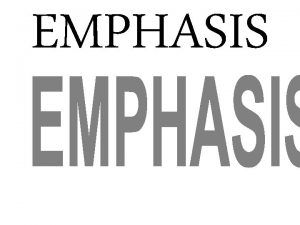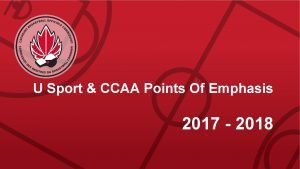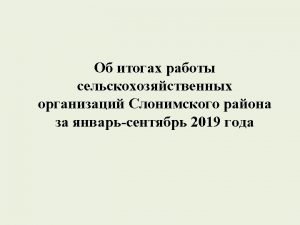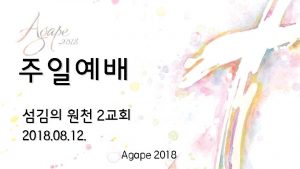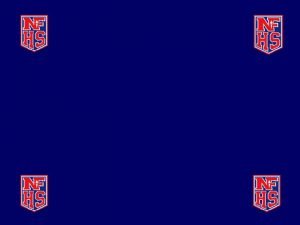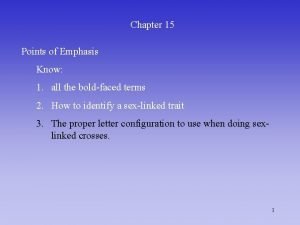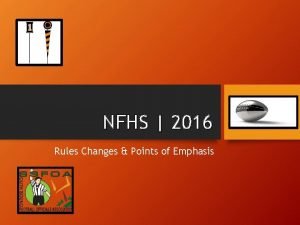National Points Of Emphasis 2018 2019 POINTS OF
































- Slides: 32

National Points Of Emphasis 2018 - 2019

POINTS OF EMPHASIS PURPOSE: • To promote a “Clean Game” • To address Player Safety • To enhance Consistency among officials across Canada

PREVIOUS POINTS OF EMPHASIS 2017 -18 POE’s 1. 2. 3. 4. Post Play Dribbler Contact Bench Decorum Verticality 2010 -17 POE’s 1. 2. 3. Travelling Illegal Physical Contact Coach/Official Interaction

2018 -2019 POINTS OF EMPHASIS 1. 2. 3. ILLEGAL CONTACT SCREENING GAME CONTROL

2018 -2019 POINTS OF EMPHASIS 1. Illegal Contact A. B. C. 2. Screening A. B. 3. Emphasis on Dribbler contact & contact on perimeter players off-ball Contact away from the ball – players being “jammed” or “bumped” on cuts to the basket Post Play – “points of contact” Ball screen defense – defenders displacing screeners…often into the offensive player Screener responsibilities (extension of elbows, width of screener’s feet) Game Control A. Bench Decorum A. Including addressing substitutes and accompanying persons who stand & react to a good play and remain standing Coach-Official Interaction

2018 -2019 POINTS OF EMPHASIS #1 – ILLEGAL CONTACT Dribbler Contact

2018 -2019 POINTS OF EMPHASIS ILLEGAL CONTACT - DRIBBLER q Remember the rule: • 33. 4 Guarding a player who controls the ball • When guarding a player who controls (holding or dribbling) the ball, the elements of time and distance do not apply. • The player with the ball must expect to be guarded and must be prepared to stop or change his direction whenever an opponent takes an initial legal guarding position in front of him, even if this is done within a fraction of a second. • The guarding (defensive) player must establish an initial legal guarding position without causing contact before taking his position (Facing his opponent and has both feet on the floor). • Once the defensive player has established an initial legal guarding position, he may move to guard his opponent, but he may not extend his arms, shoulders, hips or legs to prevent the dribbler from passing by him.

2018 -2019 POINTS OF EMPHASIS ILLEGAL CONTACT - DRIBBLER • The focus is on “freedom of movement” with due consideration given to Rhythm, Speed, Balance, and Quickness (RSBQ). • This area must be addressed from the start of every game. If it is dealt with early, it will clean itself up right away. We must be consistent with this play situation. • In assessing dribbler contact it is imperative to determine who is initiating the contact, offense or defense.

2018 -2019 POINTS OF EMPHASIS ILLEGAL CONTACT - DRIBBLER • The touching of an opponent with one hand is, in itself, not necessarily a foul. • Placing two hands on a dribbler is always a foul. • The officials shall decide whether the player who caused the contact has gained an advantage. If contact caused by a player in any way restricts the freedom of movement of an opponent, such contact is a foul. • Illegal use of the hand(s) or extended arm(s) occurs when the defensive player is in a guarding position and his hand(s) or arm(s) is placed upon and remains in contact with an opponent with or without the ball, to impede his progress. • To repeatedly touch or 'jab' an opponent with or without the ball is a foul, as it may lead to rough play.

2018 -2019 POINTS OF EMPHASIS ILLEGAL CONTACT - DRIBBLER • Officiate all contact situations (front court and back court) consistently – a defensive player may momentarily touch an opponent with his hand anywhere on the court as long as it does not affect the opponent’s movement (RSBQ) • A single hand may be allowed momentarily to allow the defender to “find” the dribbler but if the hand remains on to impede the dribbler’s progress, or the contact is repetitive a foul should be called. • Under no circumstances may the defensive player place two hands upon an opponent. • Body bumping by the defender is a foul and must be addressed.

2018 -2019 POINTS OF EMPHASIS ILLEGAL CONTACT - DRIBBLER • Actions by the ball carrier that prevent the defender from protecting their space should result in a foul being called on the ball carrier. • It is a foul by an offensive player with the ball to: Ø 'Hook' or wrap an arm or an elbow around a defensive player in order to obtain an advantage. Ø 'Push off' to prevent the defensive player from playing or attempting to play the ball, or to create more space for himself. Ø Use an extended forearm or hand, while dribbling, to prevent an opponent from gaining control of the ball. Once again, always judge who is causing the contact.

2018 -2019 POINTS OF EMPHASIS #1 – ILLEGAL CONTACT Perimeter Players Off-Ball

2018 -2019 POINTS OF EMPHASIS ILLEGAL CONTACT – PERIMETER PLAYERS OFFBALL • We must do a much better job of officiating off-ball and calling illegal contact. • Emphasis should be focused on players being “jammed” or “bumped” on cuts to the basket. • The principles of guarding a player who does not control the ball must apply (Art. 33. 5) and officials must penalize defenders who extend their arms (forearms), shoulders, hips, or legs in the path of an opponent and this illegal contact impacts the freedom of movement on an opponent.

2018 -2019 POINTS OF EMPHASIS ILLEGAL CONTACT – PERIMETER PLAYERS OFFBALL q Remember the rule: • 33. 5 Guarding a player who does not control the ball • A player who does not control the ball is entitled to move freely on the playing court and take any position not already occupied by another player. • When guarding a player who does not control the ball, the elements of time and distance shall apply. A defensive player cannot take a position so near and/or so quickly in the path of a moving opponent that the latter does not have sufficient time or distance either to stop or change his direction. • The distance is directly proportional to the speed of the opponent, but never less than 1 normal step. • If a defensive player does not respect the elements of time and distance in taking his initial legal guarding position and contact with an opponent occurs, he is responsible for the contact. • Once a defensive player has established an initial legal guarding position, he may move to guard his opponent. He may not prevent him from passing by extending his arms, shoulders, hips or legs in his path. He may turn within his cylinder to avoid injury.

2018 -2019 POINTS OF EMPHASIS ILLEGAL CONTACT – PERIMETER PLAYERS OFFBALL • This area must be addressed from the start of every game. If it is dealt with early, it will clean itself up right away. We must be consistent with this play situation. • Establish the criteria early (first illegal contact) and maintain the criteria (first to last call). • Call the obvious; be fair, but be firm! • Do not miss the big ones.

2018 -2019 POINTS OF EMPHASIS #1 – ILLEGAL CONTACT Post Play

2018 -2019 POINTS OF EMPHASIS ILLEGAL CONTACT – POST PLAY • The principle of verticality (cylinder principle) applies also to post play. • The offensive player in the post position and the defensive player guarding him must respect each other's rights to a vertical position (cylinder). • It is a foul by an offensive or defensive player in the post position to shoulder or hip his opponent out of position or to interfere with his opponent's freedom of movement using extended arms, shoulders, hips, legs or other parts of the body.

2018 -2019 POINTS OF EMPHASIS ILLEGAL CONTACT – POST PLAY • The rules and interpretations DO NOT recognize defined “points of contact” with respect to post play (i. e. “one hand”, “one forearm”, etc. ). Officials must decide on personal contact within the spirit and intent of the rules and apply the concept of “advantage/disadvantage” consistently throughout the game. Ø Guidelines = having one hand or one bent forearm placed on an opponent in the post is not normally a foul. However, if the hand or bent forearm placed on an opponent in the post: a) holds/pushes/dislodges the opponent; or b) interferes with the opponent's freedom of movement by extending the forearm/hand outside the defender’s cylinder; …A FOUL MUST BE CALLED.

2018 -2019 POINTS OF EMPHASIS ILLEGAL CONTACT – POST PLAY • Post Play needs to be addressed early in the game. If preventative officiating is not effective, call the foul. Call the first foul, not the second or third foul. If you do not call post play it will lead to rough play. • Post play should be viewed anticipated as a physical (not rough) match-up between two opponents, especially big players. • A player shall not hold, block, push, charge, trip or impede the progress of an opponent by extending his hand, arm, elbow, shoulder, hip, leg, knee or foot, nor by bending his body into an 'abnormal' position (outside his cylinder), nor shall he indulge in any rough or violent play. A foul must be called.

2018 -2019 POINTS OF EMPHASIS ILLEGAL CONTACT – POST PLAY • Any displacement by Offense or Defense is a foul. It is imperative to determine who is initiating the contact, offense or defense. If the offensive player is dislodging or “backing down” the defender by creating illegal contact, this is a foul and should be called. • Post Play can involve significant contact between players as long as one of the players is not placed at a disadvantage because of illegal contact. Do not penalize bigger players who post up against shorter, smaller players. Deem illegal contact as a foul based on the above parameters.

2018 -2019 POINTS OF EMPHASIS ILLEGAL CONTACT – POST PLAY CHECKLIST • “Easy”/”No hands”/”Keep it Legal” on action (not too many words & not on a continued basis) • There can be no “let them play” attitude when the contact is excessive • Moving to the right place to see the play from the beginning • Move to get the right spacing and angle • Identify and focus on appropriate physical action • Call the action and not the gesture (be conscious of embellishment & flopping) • When controlling the post play, you have to control 3 seconds too

2018 -2019 POINTS OF EMPHASIS #2 - SCREENING

2018 -2019 POINTS OF EMPHASIS SCREENING q Remember the rule: • 33. 7 Screening: Legal and illegal • Legal screening is when the player who is screening an opponent: • • Was stationary (inside his cylinder) when contact occurred. • Had both feet on the floor when contact occurred. Illegal screening is when the player who is screening an opponent: • Was moving when contact occurred. • Did not give sufficient distance in setting a screen outside the field of vision of a stationary opponent when contact occurred. • Did not respect the elements of time and distance of an opponent in motion when contact occurred.

2018 -2019 POINTS OF EMPHASIS SCREENING • If the screen is set within the field of vision of a stationary opponent (front or lateral), the screener may establish the screen as close to him as he wishes, provided there is no contact. • If the screen is set outside the field of vision of a stationary opponent, the screener must permit the opponent to take 1 normal step towards the screen without making contact. • If the opponent is in motion, the elements of time and distance shall apply. The screener must leave enough space so that the player who is being screened is able to avoid the screen by stopping or changing direction. • The distance required is never less than 1 and never more than 2 normal steps. • A player who is legally screened is responsible for any contact with the player who has set the screen.

2018 -2019 POINTS OF EMPHASIS SCREENING • Screener responsibilities • Stationary (inside cylinder) when contact occurs. • Both feet on the floor when contact occurs. The distance between his feet will vary according to his height. • The hands and arms may be extended in front of the torso no further than the position of the feet, with the arms bent at the elbows so that the forearms and hands are raised. Arms may be crossed in front of the screener, BUT must remain within his/her cylinder. • A player who has set a screen must not EXTEND his/her arms, elbows, shoulders, hips, or legs when contact occurs. • Guideline = screen width is limited to the inside of the feet in line with the shoulders

2018 -2019 POINTS OF EMPHASIS SCREENING • This area must be addressed from the start of every game. If it is dealt with early, it will clean itself up right away. We must be consistent with this play situation. • Establish the criteria early (first call) and maintain the criteria (last call). • Pay particular attention to the player setting the screen who contacts an opponent and subsequently holds or pushes the opponent and interferes with his freedom of movement. This contact can occur with any part of the body. • Conversely, pay attention to ball screen defenders displacing screeners…often into the offensive player at elbows. A pushing foul must be called to clean up the game.

2018 -2019 POINTS OF EMPHASIS #3 - GAME CONTROL

2018 -2019 POINTS OF EMPHASIS GAME CONTROL – Bench Decorum / Coach-Official Interaction Positive interaction between Coaches & Officials is essential and expected. The game is for the players, not the Coaches or the Officials. • There is a Team Bench Area that must be marked on the court. Coaches must remain within the Team Bench Area at all times unless to request a time out at the scorer’s table. • Only one of the Head Coach, or, the designated Assistant Coach on each team may be standing at any time. • Coaches should not expect an official to respond during a live ball or, any other time the clock is running.

2018 -2019 POINTS OF EMPHASIS GAME CONTROL – Bench Decorum / Coach-Official Interaction • Officials should not respond to statements by Coaches, only reasonable questions. Responses to questions should be short and direct to the question asked. • The Head Coach is responsible for the actions of all bench personnel. If an official is uncomfortable with the actions of bench personnel, their first action should be to request the assistance of the Head Coach in dealing with this. If it persists, a technical foul could be assessed and it is charged to the Head Coach (B 1). • Profanity, disrespectful comments, and/or gestures will result in the assessment of a technical foul. A warning may or may not be given depending on the circumstances. Aggressive gestures will never be acceptable behaviour.

2018 -2019 POINTS OF EMPHASIS GAME CONTROL – Bench Decorum / Coach-Official Interaction • Excessive and/or lengthy conversations with Coaches should be avoided during the game. If explanations are required they need to be short, polite, and concise. • It is the responsibility of the officials to control the game and address inappropriate conduct and actions of the Head Coach and any bench personnel during the game. Respect, politeness, and firmness are the keys to doing this successfully.

2018 -2019 POINTS OF EMPHASIS GAME CONTROL – Bench Decorum / Coach-Official Interaction • Article 7. 3 reads, “The coaches, assistant coaches, substitutes, excluded players and accompanying delegation members are the only persons permitted to sit on the team bench and remain within their team bench area. During playing time all substitutes, excluded players and accompanying delegation members shall remain seated. • Allowance should be provided to permit substitutes, excluded players and accompanying delegation members to stand & react to a good play momentarily (immediately sitting down afterwards).

Thank you!
 V diagram newmark
V diagram newmark Contrast by isolation is also described as:
Contrast by isolation is also described as: Emphisis
Emphisis Dada la siguiente secuencia rusia 2018 rusia 2018
Dada la siguiente secuencia rusia 2018 rusia 2018 Conest 2021 captura de calificaciones
Conest 2021 captura de calificaciones Resultat ufr sed 2018-2019
Resultat ufr sed 2018-2019 Tanzania national nutrition survey 2020
Tanzania national nutrition survey 2020 Tanzania national nutrition survey 2020
Tanzania national nutrition survey 2020 Kvs regional sports meet 2018-19
Kvs regional sports meet 2018-19 2018 national patient safety goals
2018 national patient safety goals National service framework for children/ 2018
National service framework for children/ 2018 National business group on health conference 2018
National business group on health conference 2018 2018 national patient safety goals
2018 national patient safety goals National geographic photo contest 2018
National geographic photo contest 2018 Cao points 2019
Cao points 2019 Six ministerial priorities department health
Six ministerial priorities department health Cdha national conference 2019
Cdha national conference 2019 Cdha careers
Cdha careers Points of parity and points of difference
Points of parity and points of difference Points of parity and points of difference
Points of parity and points of difference National unification and the national state
National unification and the national state Spice (simulation program with integrated circuit emphasis)
Spice (simulation program with integrated circuit emphasis) Emphasis by contrast
Emphasis by contrast Emphasis is also called
Emphasis is also called Vocal emphasis
Vocal emphasis Ias 500
Ias 500 The incremental decision process model places emphasis on:
The incremental decision process model places emphasis on: Principles of photography
Principles of photography It is a movement in which some elements recur regularly
It is a movement in which some elements recur regularly Areas of special emphasis examples
Areas of special emphasis examples Positive emphasis
Positive emphasis Entrance là loại hoạt cảnh
Entrance là loại hoạt cảnh Personal process model
Personal process model
